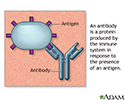Chagas disease
Parasite infection - American trypanosomiasisChagas disease is an illness caused by tiny parasites and spread by insects. The disease is common in South and Central America.
Causes
Chagas disease is caused by the parasite Trypanosoma cruzi. It is spread by the bite of reduviid bugs, or kissing bugs, and is one of the major health problems in South America. Due to travel and immigration, the disease also affects people in the United States.
Risk factors for Chagas disease include:
- Living in a hut where reduviid bugs live in the walls
- Living in Central or South America
- Poverty
- Receiving a blood transfusion or an organ donation from a person who carries the parasite, but does not have active Chagas disease
Symptoms
Chagas disease has two phases: acute and chronic. The acute phase may have no symptoms or very mild symptoms, including:
Acute
Acute means sudden. Acute symptoms appear, change, or worsen rapidly. It is the opposite of chronic.

Chronic
Chronic refers to something that continues over an extended period of time. A chronic condition is usually long-lasting and does not easily or quick...

- Fever
- General ill feeling
- Swelling of an eye if the bite is near the eye
- Swollen red area at the site of the insect bite
After the acute phase, the disease goes into remission. There may be no other symptoms for many years. When symptoms finally develop, they may include:
- Constipation
- Digestive problems
- Pain in the abdomen
-
Swallowing difficulties
Swallowing difficulties
Difficulty with swallowing is the feeling that food or liquid is stuck in the throat or at any point before the food enters the stomach. This proble...
 ImageRead Article Now Book Mark Article
ImageRead Article Now Book Mark Article -
Pounding or racing heart
Pounding or racing heart
Palpitations are feelings or sensations that your heart is pounding or racing. They can be felt in your chest, throat, or neck. You may:Have an unpl...
 ImageRead Article Now Book Mark Article
ImageRead Article Now Book Mark Article -
Heart failure
Heart failure
Heart failure is a condition in which the heart is no longer able to pump oxygen-rich blood to the rest of the body efficiently. This causes symptom...
 ImageRead Article Now Book Mark Article
ImageRead Article Now Book Mark Article
Exams and Tests
A physical exam can confirm the symptoms. Signs of Chagas disease may include:
Physical exam
During a physical examination, a health care provider checks your body to determine if you do or do not have a physical problem. A physical examinati...

- Disease of the heart muscle
- Enlarged liver and spleen
-
Enlarged lymph nodes
Enlarged lymph nodes
Lymph nodes are present throughout your body. They are an important part of your immune system. Lymph nodes help your body recognize and fight germ...
 ImageRead Article Now Book Mark Article
ImageRead Article Now Book Mark Article - Irregular heartbeat
- Rapid heartbeat
Tests include:
-
Blood culture to look for signs of infection
Blood culture
A blood culture is a laboratory test to check for bacteria or other germs in a blood sample.
 ImageRead Article Now Book Mark Article
ImageRead Article Now Book Mark Article -
Chest x-ray
Chest x-ray
A chest x-ray is an x-ray of the chest, lungs, heart, large arteries, ribs, and diaphragm.
 ImageRead Article Now Book Mark Article
ImageRead Article Now Book Mark Article -
Echocardiogram (uses sound waves to create pictures of the heart)
Echocardiogram
An echocardiogram is a test that uses sound waves to create pictures of the heart. The picture and information it produces is more detailed than a s...
 ImageRead Article Now Book Mark Article
ImageRead Article Now Book Mark Article -
Electrocardiogram (ECG, tests electrical activity in the heart)
Electrocardiogram
An electrocardiogram (ECG) is a test that records the electrical activity of the heart.
 ImageRead Article Now Book Mark Article
ImageRead Article Now Book Mark Article - Enzyme-linked immunoassay (ELISA) to look for signs of infection
ELISA
ELISA stands for enzyme-linked immunoassay. It is a commonly used laboratory test to detect antibodies in the blood. An antibody is a protein produ...
 ImageRead Article Now Book Mark Article
ImageRead Article Now Book Mark Article -
Blood smear to look for signs of infection
Blood smear
A blood smear is a blood test that gives information about the number and shape of blood cells. It is often done as part of or along with a complete...
 ImageRead Article Now Book Mark Article
ImageRead Article Now Book Mark Article
Treatment
The acute phase of reactivated Chagas disease should be treated. Infants born with the infection should also be treated.
Treating the chronic phase is recommended for children and most adults. Adults with chronic phase Chagas disease should talk to their health care provider to decide whether treatment is needed.
Two medicines are used to treat this infection: benznidazole and nifurtimox.
Both medicines often have side effects. The side effects may be worse in older people. They may include:
- Headaches and dizziness
- Loss of appetite and weight loss
- Nerve damage
- Problems sleeping
- Skin rashes
Outlook (Prognosis)
About one third of infected people who are not treated will develop chronic or symptomatic Chagas disease. It may take more than 20 years from the time of the original infection to develop heart or digestive problems.
Symptomatic
Symptomatic can mean showing symptoms, or it may concern a specific symptom. Symptoms may be signs of disease or injury. They are what a person fee...

Abnormal heart rhythms may cause sudden death. Once heart failure develops, death usually occurs within several years.
Possible Complications
Chagas disease can cause these complications:
- Enlarged colon
- Enlarged esophagus with swallowing difficulty
- Heart disease
- Heart failure
-
Malnutrition
Malnutrition
Malnutrition is the condition that occurs when your body does not get enough nutrients.
 ImageRead Article Now Book Mark Article
ImageRead Article Now Book Mark Article
When to Contact a Medical Professional
Contact your provider for an appointment if you think you may have Chagas disease.
Prevention
Insect control with insecticides and houses that are less likely to have high insect populations will help control the spread of the disease.
Blood banks in Central and South America screen donors for exposure to the parasite. The blood is discarded if the donor has the parasite. Most blood banks in the United States began screening for Chagas disease in 2007.
References
Kirchoff LV. Chagas disease. In: Goldman L, Cooney KA, eds. Goldman-Cecil Medicine. 27th ed. Philadelphia, PA: Elsevier; 2024:chap 318.
Kirchhoff LV. Trypanosoma species (American trypanosomiasis, Chagas' disease): biology of trypanosomes. In: Bennett JE, Dolin R, Blaser MJ, eds. Mandell, Douglas, and Bennett's Principles and Practice of Infectious Diseases. 9th ed. Philadelphia, PA: Elsevier; 2020:chap 276.
Salvana EMT, Salata RA. American Trypanosomiasis (Chagas Disease; Trypanosoma cruzi). In: Kliegman RM, St. Geme JW, Blum NJ, et al, eds. Nelson Textbook of Pediatrics. 22nd ed. Philadelphia, PA: Elsevier; 2025:chap 333.
-
Kissing bug - illustration
Triatomid, the kissing bug, can carry Chagas' disease (American trypanosomiasis). (Image courtesy of the Centers for Disease Control and Prevention.)
Kissing bug
illustration
-
Antibodies - illustration
Antigens are large molecules (usually proteins) on the surface of cells, viruses, fungi, bacteria, and some non-living substances such as toxins, chemicals, drugs, and foreign particles. The immune system recognizes antigens and produces antibodies that destroy substances containing antigens.
Antibodies
illustration
-
Kissing bug - illustration
Triatomid, the kissing bug, can carry Chagas' disease (American trypanosomiasis). (Image courtesy of the Centers for Disease Control and Prevention.)
Kissing bug
illustration
-
Antibodies - illustration
Antigens are large molecules (usually proteins) on the surface of cells, viruses, fungi, bacteria, and some non-living substances such as toxins, chemicals, drugs, and foreign particles. The immune system recognizes antigens and produces antibodies that destroy substances containing antigens.
Antibodies
illustration
Review Date: 11/10/2024
Reviewed By: Jatin M. Vyas, MD, PhD, Roy and Diana Vagelos Professor in Medicine, Columbia University Vagelos College of Physicians and Surgeons, Division of Infectious Diseases, Department of Medicine, New York, NY. Also reviewed by David C. Dugdale, MD, Medical Director, Brenda Conaway, Editorial Director, and the A.D.A.M. Editorial team.



